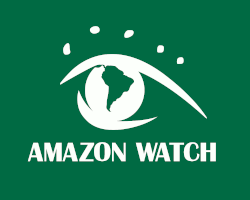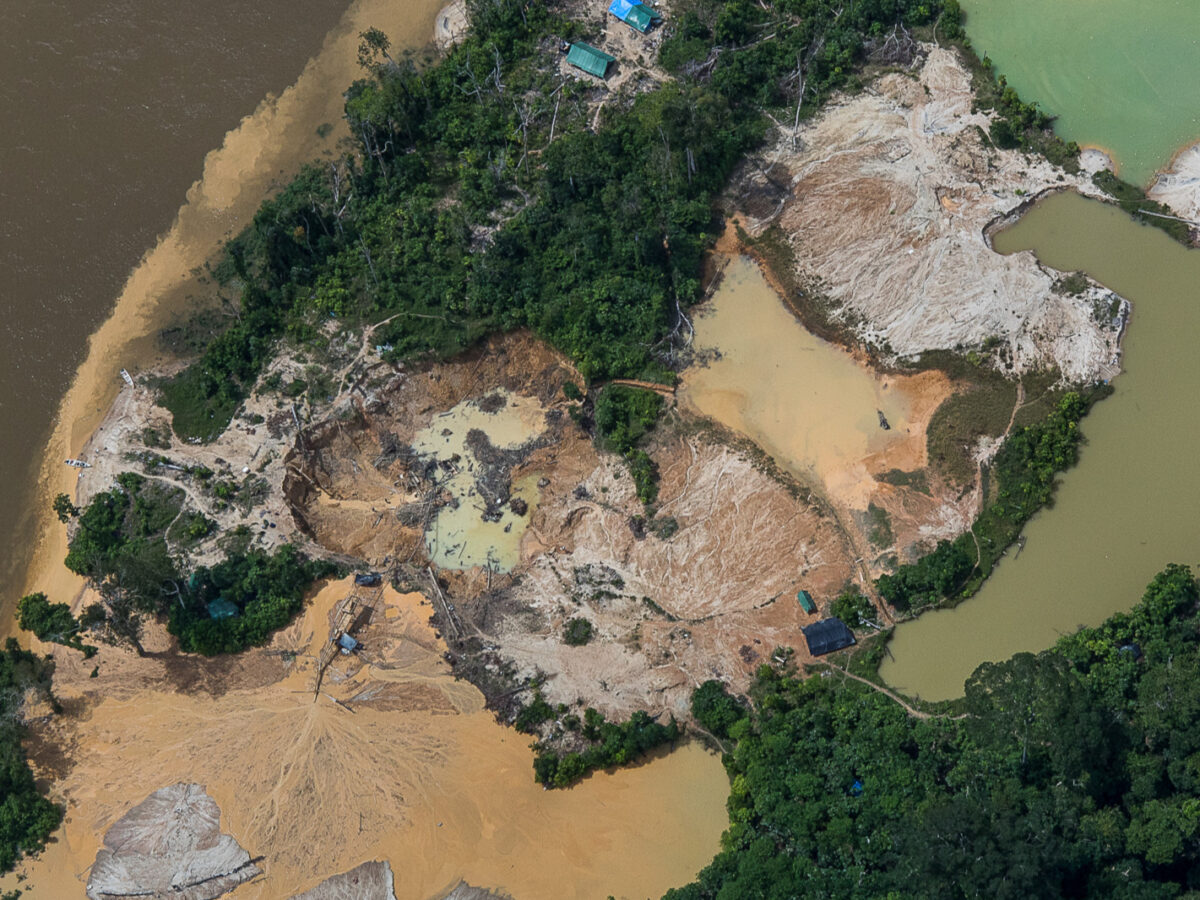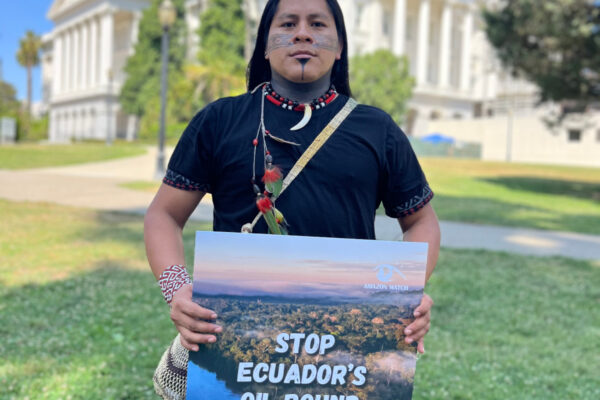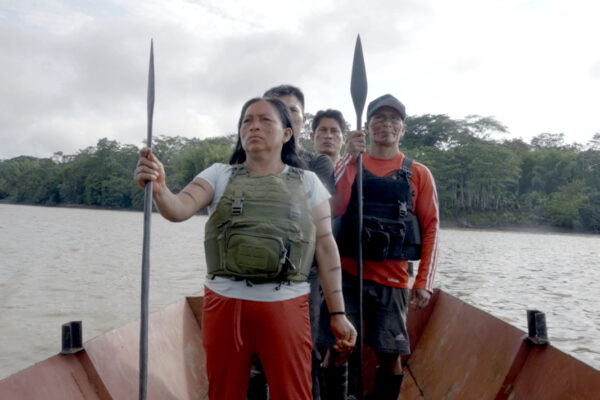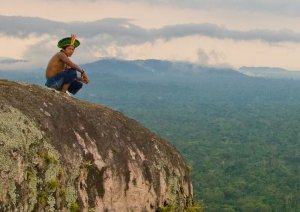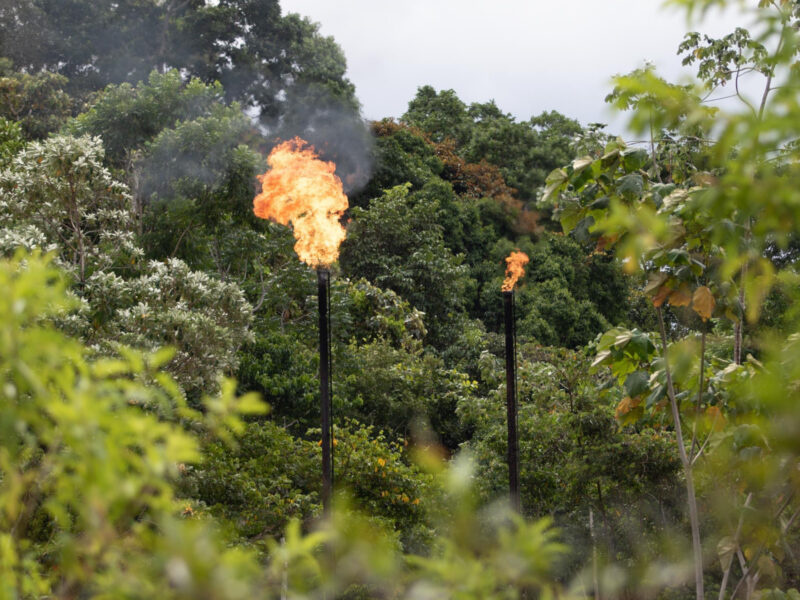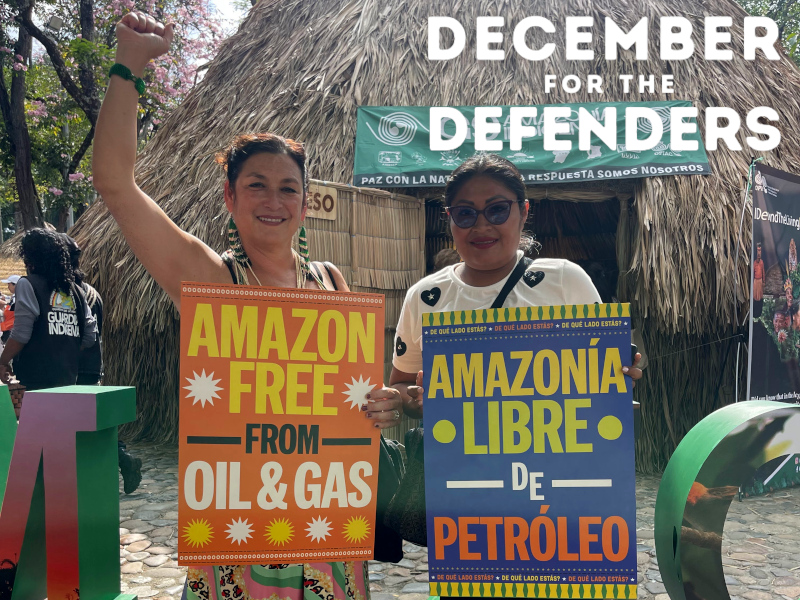Dutch by birth but living in Latin America for two decades, Raphael Hoetmer has travelled the Amazon rivers alongside Indigenous defenders and peasants to collaborate in their struggles for territory and conservation, but every time he returns to the Amazon in Peru, Colombia or Ecuador, dredgers dominate his thoughts. How can this be happening? Hoetmer thinks it’s crazy. He feels helpless, he admits, but it’s reality.
Every time he returns to the same places, to the same rivers, the dredgers have multiplied. Trip after trip, like when he enters the Tambopata Natural Reserve in Peru, and sees the dredgers extracting gold from the river in the middle of the Amazon, in full view of everyone, on the edge of the reserve or even inside it. It is illegal, it is visible to the authorities and security forces but it spreads like a poisonous stain. Behind it, there is much more than illegal armed groups, he says. There is a global gold market, there are governments, there is a political class, and there are mining companies established as legal companies.
What is the current situation regarding illegal mining in the western Amazon?
Hoetmer is the director of the Western Amazon Program at Amazon Watch, an international organization that seeks to protect the rainforest and its inhabitants. He is a researcher and educator, specializing in political ecology, Indigenous rights, and participatory and intercultural methodologies. He lives in Peru but his work also covers the problems of the Amazon in Ecuador and Colombia.
Both the visits to the territories and the studies indicate that this is an extremely critical moment. There is an explosion of illegal mining, due, in part, to the high prices of gold. In the last five years, the onset of the pandemic, increase in poverty and devastation of the territories, and more developed and structured strategies of criminal groups have led to a dramatic expansion in many areas of the Amazon where there was previously no illegal mining.
So, obviously we have historical areas of mining and gold exploitation, such as in Madre de Dios, Peru. In the case of Peru, this is already appearing throughout the entire Amazon and I think similar things are happening in other countries. One sees, not only an expansion of the activity, but also a deepening of political and territorial control. And one also sees, I would say, an increasingly strong penetration of the local social fabric, including Indigenous communities. It is a devastating scenario. Criminal economies, and illegal mining in particular, are penetrating territories that until now had maintained a certain capacity to preserve themselves in the face of large-scale mining and oil extraction. It is amplifying extractivism in the most biodiverse parts of the Amazon and a region with strong Indigenous organization and self-determination, such as the Wampis and Awajún territories in Peru, or the Shuar and Napo territories in Ecuador.
You just mentioned the dramatic increase in the price of gold on the international market. Has this phenomenon had a serious impact on the Amazon and its inhabitants?
Without a doubt. On the one hand, this has made gold mining much more attractive than it already was for organized crime groups, as a money laundering activity, for example, but also as an investment opportunity in Peru. Reports estimate that illegal mining is a more profitable activity than drug trafficking today. So one sees a convergence of different types of economic activities, the surpluses generated by gold and at the same time gold as a measure or means of laundering. This has made gold a very central activity in the networks and processes of organized crime.
How is money laundering connected to illegal mining and criminal groups?
The issue is that much of the income from drug trafficking can currently be laundered through the investment of these groups in mining or the marketing of gold.
Is illegal mining in the Amazon carried out solely by organized crime groups? Who are the different groups that practice this illegal activity?
There is a risk of talking about this as an isolated phenomenon, when in reality there is a heterogeneity between countries and within each country. Gold mining is supported by complex networks and there are miners who may be community members who have come down from the Andes for periods of time to do the activity, as they have done for a long time. There are mining operators who are more established in the territory, which is a next level. Then there is a level that obviously has to do with inputs, with marketing. But what I do think we see is that in some way it is the control or connection of mining activities in the territory with organized violence groups. Organized crime is increasingly stronger compared to ten years ago, when there was much more activity by these mining groups.
How was that process?
They are violent processes. In the Podocarpus Natural Park in Ecuador, there were clashes between groups of miners who resist being under the control of Los Lobos. These are not automatic processes. In southern Peru, the reality is very different from that on the northern border, with the Awajún or the Wampis, but in general we see a trend: there are more weapons, there is more violence, there is more control and more involvement of organized crime groups, such as the Border Commands, the PSC, the Comité Vermelho, Los Lobos or other groups, such as the National Liberation Army (ELN) in the case of Venezuela. This also means that the more community-based dynamics of mining exploitation are increasingly conditioned, controlled and taken over by these actors.
What is your work like in these territories?
Our way of working combines processes of international advocacy and international campaigns and research with solidarity support for groups on the ground, which means that we do not have to work in the territory all the time, as some national or local NGOs may have. For this reason, we do not run too many risks, but the people we work with are increasingly asking us for support for security and protection issues. We see that there are more and more leaders who cannot stay in the territory and who, therefore, need support in this sense. The main concern is the level of violence, of threat, of conditioning. We see that Indigenous organizations are absolutely fundamental to contain the expansion of illegal mining. But at the same time, this work is becoming increasingly dangerous. Governmental institutions are not sufficiently supporting efforts to contain criminal economies and we have leaders murdered in different parts of the Amazon. We have a growing phenomenon of forced displacement of specific leaders who are critical of illegal mining or drug trafficking.
Do you think that illegal mining is currently one of the main threats to the Amazon?
Yes, but I have two nuances. We no longer analyze illegal mining and drug trafficking and other illicit activities as separate things. We do not analyze by sector which is more dangerous. We think that what is being established is a criminal governance that has different types of economic activities, increasingly diversified economies and a lot of political influence, many formal legal arms as well. So, what seems dangerous to us is that criminal governance is expanding and that it is becoming more and more violent. So, I would not say so much that illegal mining is the main threat. The main threat seems to me to be that criminal economies are constituting a type of governance with a lot of complicity from governments, in some countries more than in others. And this is the main threat to the Amazon, to Indigenous territories and, ultimately, also to the climate. The second nuance is that there is a risk in stating that illegal mining is the main threat because we do not want to promote formal mining as a response. We also see a discourse that suggests that we need to combat illegal mining but at the same time promote legal mining, particularly in the context of the energy transition and critical transition minerals. We believe that this is a fallacy because in reality, formal mining in the Amazon is also very harmful, perhaps not as brutally as illegal mining, but it is equally harmful with respect to pollution and violence. We think that there should be no mining in the Amazon at all; it should be designated as a no-go zone.
How does legal mining operate in the Amazon?
We see that in different parts of the Andes and the Amazon, formal mining and illegal mining coexist or converge. In fact, gold generally leaves the country through the same channels, whether legal or illegal. In general, my opinion is that gold mining is somewhat unnecessary in today’s world and especially in the Amazon, which is totally unjustified due to its serious impact.
You spoke of a political arm and a well-established legal arm of criminal groups, you spoke of governmental complicity. As far as you can tell us for security reasons, how do these three arms work?
What is called illegal mining actually has complicity, collaboration, and support from governmental institutions and from global markets. It is true that the realities are different in different countries. In Brazil and Colombia, the current governments have more critical positions regarding illegal mining, which translate into more coherent initiatives. Particularly in Brazil, improved results can be seen, compared to the administration of Jair Bolsonaro, although they are still insufficient. In the case of Venezuela, my impression is that illegal gold mining has become a main source of income for the country’s political elites, even more so in the midst of the crisis in the oil sector, which causes illegal mining to be promoted by very complex networks of governmental actors, military, armed groups and others.
In the case of Bolivia, the mining cooperative that structures the mining expansion in the country also has close relations with the government. And in the case of Peru, what we see is that miners have representation in different political forces, from the local to the national level. It is very likely that in the next regional election the political power of criminal economies will be significantly amplified.
We see that local and regional governments are practicing corruption schemes that lead to the granting of property titles to lands that are actually Indigenous territories, or to the lack of action against certain environmental crimes. We also see the lack of equipment with budgets, resources, capacities and political support to the agencies in charge of conservation, protection of defenders or environmental regulation. In essence, they reflect the decision not to seriously combat these activities.
We can say that illegal mining is actually supported by actions and omissions from political institutions, and at the same time, promoted and backed by the mechanisms of the global market. This is why when people act against this type of activity, it is very difficult for them to find support and collaboration from governmental forces. In Peru we can see how the mechanism for the protection of defenders has been almost paralyzed since the end of last year. In Ecuador, it does not even exist.
With the latest decisions on cooperation from the United States, and other cuts likely in the European Union and the United Kingdom, support for Indigenous, environmental and other organizations is going to be even more reduced at this critical time. The Indigenous peoples and communities that are fighting this battle are being left alone.
Some of the countries you mention have opted for a police or militaristic solution to intervene in the Amazonian territories where criminal groups that practice mining operate. Do you think that is the solution?
No, that is not the way. When you analyze historically the times that this has happened, as in Madre de Dios, you realize that it led to displacement to other territories. I think that there is an element that has to do with protection and security. However, if that is not rooted in a proposal for governance and also for Indigenous and peasant territorial economy, which allows for real alternatives and the protection of those who, at the end of the day, are the only ones who can really care for and protect the territory, no police force will work. In addition, there are also problems of corruption. A famous case was when the Wampis Indigenous Guard arrested a series of people dedicated to illegal mining in their territory and four of them turned out to be police officers. I think that solutions that think that force and order are the only way to respond are an illusion. The response has to be comprehensive, it has to be territorial, it has to put governance and the economy at the center. What is true is that we need better cooperation between the police forces of different countries to coordinate their efforts with the people in the territories, for the people to be consulted on what is happening and also for defenders to be protected when they are under threat.
Do you think that the only way to overcome this phenomenon is with a joint effort at the political level between the highest governmental authorities of all the countries in the Amazon?
That should exist. Now it is very difficult for it to work effectively because countries have different political orientations. There are governments with very favorable positions towards these types of activities. The fact that the ATCO (Amazon Cooperation Treaty Organization, which brings together eight Amazonian countries) has a new authority, who understands the problem, is positive because it could obviously generate more spaces for coordination, for shared analysis. However, its mandate is not strong enough to promote these things in a robust way if governments refuse to do so. The basis should be coordination with those who know what is happening and are having global efforts for conservation and protection of their territory, whether they are Indigenous peoples or peasant communities. I think that local civil society and journalists are other key elements. And the local authorities who are taking critical attitudes. But without greater cross-border cooperation, we will continue to see that there is an operation on the Colombian side of the border and the dredges disappear and go to the Peruvian side to then return the following month to the Colombian side. Obviously this is a product of the criminal governance that exists in the Amazon. It is totally cross-border. The organizations are extremely skilled at moving to different sides of the border.
Apart from threats and displacement, are there other ways in which this phenomenon is disrupting the lives of local populations?
There are many ways. On the one hand, there are impacts on the environment and on community health. Mercury has tremendous consequences on the health of rivers. Mercury enters the fish, the fish are eaten by people. There are many studies in different countries on this. More and more Amazonian territories are being devastated, they no longer provide a dignified, sustainable life for their inhabitants as they did before, because the pressures of activities, including oil, for example, from the cities and particularly from illegal mining, are leading to this. So the territories are becoming impoverished, which is why people are becoming impoverished, which is why illegal mining and drug trafficking are also becoming more attractive. So we see impoverishment, we see damage to health, we see effects on biodiversity. There are phenomena of recruitment of minors, there are signs of human trafficking, sexual violence against women. In reality, one could see a complete alteration of life in these spaces. And I think we have to be honest about this too: in the absence of other economic opportunities, in many cases we see the participation of the communities themselves in these activities, because there is no other option. This creates many divisions, conflicts, tensions within the communities themselves.
Are children and women particularly affected by the phenomenon?
Yes, I think there are different impacts. Murders are usually more of men than of women. There are cases of murdered women defenders, but they are a minority. But women experience other types of impacts. For example, it can happen that men leave the territory for safety and women are left to have to deal with this. Human trafficking affects women more. Sexual violence disproportionately impacts women, too. But also pollution, for example. They are the ones who respond to the impacts on health, they are the ones who have to find new sources of water to bring to the community. So, I would say that women are often the ones who have a very strong voice in the face of these phenomena because they are the ones who see more clearly the comprehensive impacts on life. It is also true that the economic benefits that these activities generate often remain much more in the hands of men, and there are also phenomena such as, for example, the expansion or growth of HIV and other sexually transmitted diseases in the Awajún people. All these things come with increased mining activity. Men who go to work, earn money that they spend, at least partially on alcohol, on sexual services. And what comes back to the women and the community are only the harmful impacts.
